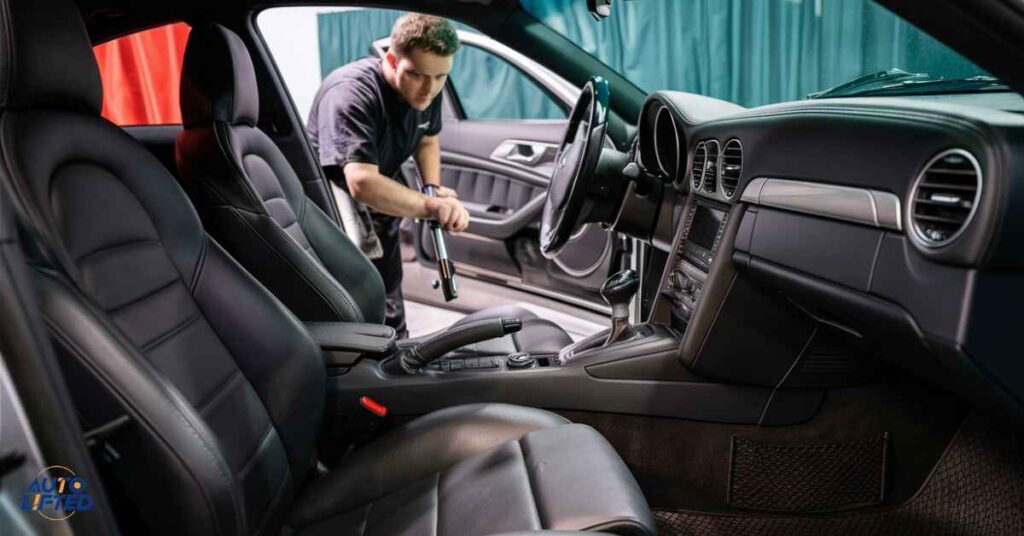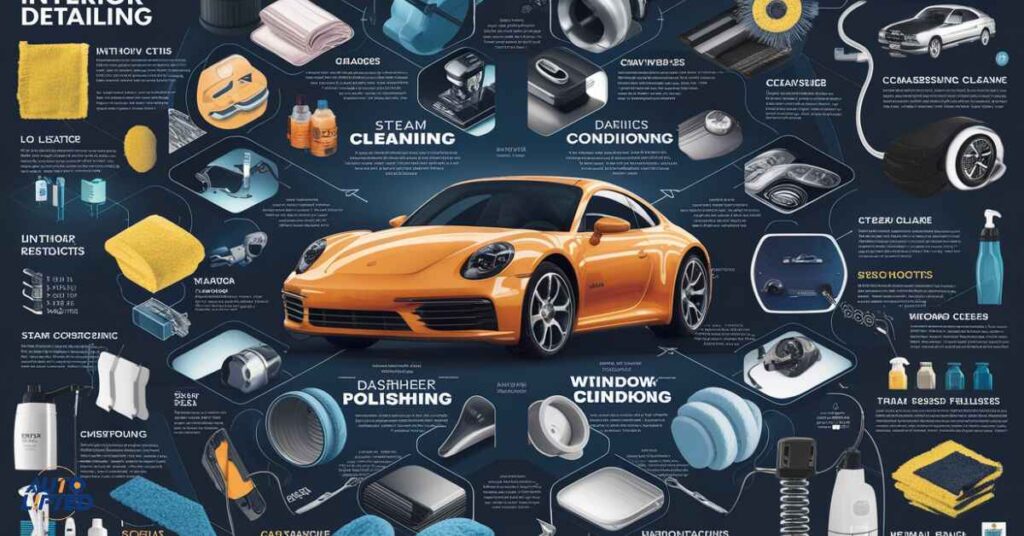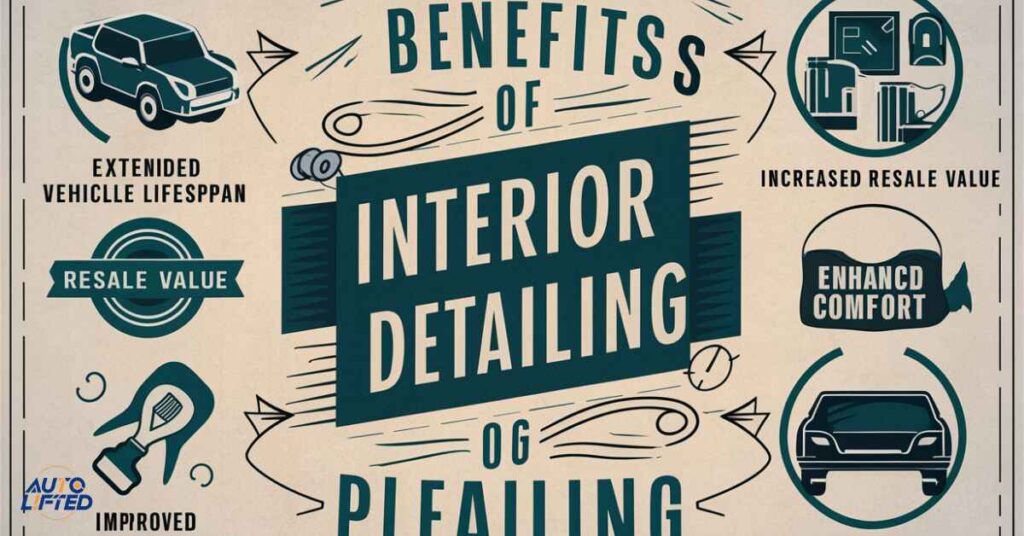Car interior detailing is the process of cleaning and restoring a car’s interior. It enhances both appearance and hygiene. Services include cleaning surfaces, upholstery, carpets, and more. Professionals use special tools and products.
Detailing removes dust, dirt, and stains. It protects against wear and tear. The process can extend the life of your car’s interior. DIY methods are possible but may not match professional results. Regular detailing keeps your car looking new and increases its value.
Why Car Interior Detailing is Crucial

Keeping your car’s interior clean and well-maintained is about more than just appearances – it’s an investment in preserving the vehicle’s overall value and longevity.
Professional car interior detailing plays a vital role in extending the life of materials like leather, vinyl, and fabric upholstery by removing built-up dirt, grime, and contaminants that can cause premature wear.
But beyond protecting your financial investment, interior detailing improves cabin air quality by eliminating allergens, odors, and bacteria that can accumulate. This creates a fresher, more inviting driving environment that’s both comfortable and hygienic for you and your passengers.
Perhaps most importantly, a well-detailed interior conveys a sense of pride and joy in your vehicle. Just like getting a haircut can boost your self-confidence, having a professionally cleaned and restored interior elevates the simple act of driving into an enjoyable experience you’ll look forward to.
Read This Blog:
How Long Does It Take To Import A Car From Japan
Don’t underestimate the psychological benefits of this “like new” feeling. To illustrate this point, consider this anecdote: A friend recently purchased a 10-year-old SUV that had clearly been neglected by its previous owner.
While the exterior was decent, the interior was atrocious – stained seats, crumbs in every crevice, hazy windows, and an overwhelming scent of stale air. After paying around $200 for a professional interior detailing service, the difference was astonishing.
What was once an unpleasant cabin became a point of pride, leaving my friend feeling like he’d just bought a brand new luxury vehicle. The value of that psychological impact can’t be overstated.
What’s Included in Professional Interior Detailing

So what exactly is involved in a comprehensive interior car detailing service? While specific services may vary, most professional detailers will cover the following:
Vacuuming Carpets, Seats, and Tight Crevices
Using powerful vacuums and specialized tools, detailers will extract every speck of dirt, debris, pet hair, and crumbs from your car’s carpets, upholstered seats, and hard-to-reach nooks and crannies.
Cleaning All Surfaces
From the dash and console to door panels, cup holders, and more, every interior surface gets a thorough cleaning using automotive grade products. This involves safely removing built-up grime, fingerprints, water stains, and hazy residue.
Conditioning Leather and Vinyl
If your car has leather seats or vinyl surfaces, they’ll be properly cleaned, conditioned, and protected to prevent cracking, fading, and premature wear.
Steaming/Shampooing Fabrics and Carpets
Using steam cleaners and spot removers, fabric upholstery and carpets get a deep cleaning to lift out embedded dirt and stains.
Dressing and Protecting Surfaces
After cleaning, interior surfaces are dressed with protectants to restore that “new car” look and provide a defensive layer against future spills, UV damage, and wear.
Removing Tough Stains and Odors
Detailers use specialized products and techniques to remove tough stains like coffee, grease, ink, and pet odors that basic cleaning can’t handle.
While you could theoretically do all this yourself, professional detailers have the expertise, specialized tools, and commercial-grade products to achieve a level of cleanliness and protection a DIY job simply can’t match.
DIY vs Professional Interior Detailing – Pros and Cons

Speaking of DIY, many vehicle owners opt to clean their car’s interiors themselves rather than pay for professional detailing. There are pros and cons to each approach:
DIY Pros:
- Cost savings vs hiring a pro
- Ability to do it on your own schedule
- Satisfaction of doing it yourself
- Learning about proper cleaning techniques
DIY Cons:
- Requires investment in tools and supplies
- Risk of damaging delicate surfaces if done incorrectly
- Often can’t achieve same level of deep cleaning
- Very time consuming for a thorough job
Professional Pros:
- Guaranteed quality results from trained experts
- Saves immense time and effort
- Commercial-grade tools and products
- Convenience of mobile service options
Professional Cons:
- Premium pricing over DIY
- Have to work around detailer’s schedule
- Potential for damage if a bad provider
For infrequent cleaning or mild messes, tackling it yourself can make sense. But for a periodic deep cleaning and rejuvenation, hiring professionals provides unmatched quality and convenience if you factor in your own time and effort.
Also This Blog:
What Happens If A Leased Car Is Totaled?
Top Benefits of Regular Interior Detailing

By now, the “why” of interior car detailing should be clear. But it’s worth summarizing the key benefits:
- Creates a “Like New” Environment: Detailing restores that fresh, clean feeling you had when you first bought your vehicle.
- Rids Car of Odors, Allergens, and Germs: A deep cleaning removes offensive smells, irritants, and harmful bacteria.
- Prevents Future Stains from Setting In: If caught early, detailing prevents surface stains from becoming permanent.
- Protects Against UV Damage, Cracking, and Fading: Conditioning treatments shield interior materials from the sun’s harsh rays.
- Maintains Materials and Components Longer: Overall, detailing extends the lifespan of your upholstery, plastics, and more.
- Increases Resale/Trade-In Value: A well-maintained, detailed interior signals pride of ownership and boosts value.
Plainly put, interior detailing is an investment that pays off through preserving your car’s condition and your enjoyment of driving it.
How Often to Get It Done
With benefits like these, you may wonder how frequently you need interior detailing services. Most professional detailers recommend:
- Light Detailing Every 3-6 Months: This quick cleaning freshens up the interior.
- Complete Interior Detail Every 6-12 Months: A deep cleaning and detailing 1-2 times per year.
However, the timeline can vary depending on:
- Vehicle Usage: Cars with higher mileage or used as workhorses may need more frequent detailing.
- Climate: Hot, sunny regions can accelerate fading and cracking of interior materials.
- Passengers: Kids and pets create much more mess than solo adult driving.
Rather than going by a schedule, look for visible signs like excessive staining, strong odors, dull/dried surfaces, or cracking and fading as cues that it’s time for detailing.
What to Look For in a Detailing Service
If you decide to use a professional car detailing service, do your due diligence in choosing the right provider. Evaluate factors like:
- Experience and Training Level: Look for companies that have been in business for years and have highly-trained detailers on staff.
- Environmentally Safe Product Usage: Ensure they use eco-friendly, water-based detailing products that are safe for kids and pets.
- Service Reviews and Reputation: Check online reviews, ratings, and get word-of-mouth recommendations.
- Service Area and Mobile Ability: See if they come to you with mobile detailing services or require dropping off your vehicle.
- Pricing and Package Options: Compare price quotes for basic vs. premium services to fit your needs and budget.
A top-quality professional detailing job isn’t cheap, but it’s worth paying for expertise and avoiding subpar results that can damage your interior.
DIY Interior Detailing – Tips and Tricks
If you opt to go the DIY route, at least periodically, here are some tips for getting professional-grade results:
Necessary Tools and Products:
- Vacuum with crevice tools
- Automotive upholstery cleaner
- Leather conditioner
- All-purpose interior cleaner
- Brushes and microfiber cloths
- Carpet/upholstery cleaner machine (optional)
Step-by-Step Process:
- Vacuum Thoroughly: Use crevice tools to reach every nook and cranny.
- Clean Surfaces: Wipe down all hard plastics and vinyl with an interior cleaner.
- Spot Clean Fabric: Spray upholstery cleaner and scrub any visible stains.
- Shampoo Carpets/Upholstery: If heavily soiled, use a rental machine or have it done professionally.
- Condition Leather: Wipe down leather seats and surfaces with a conditioner.
- Dress and Protect:
- Dress and Protect: Apply protectant products to surfaces to restore that “new” look and add a defensive layer.
Stain Removal Hacks:
- Coffee/Soda: Blot up excess, then use a 1:1 vinegar and water solution.
- Grease/Oil: Sprinkle baking soda or cornstarch to absorb, then vacuum.
- Ink/Marker: Use a cotton ball dipped in rubbing alcohol or hairspray.
- Pet Stains: Enzyme cleaners help break down proteins.
Common Mistakes to Avoid:
- Using harsh household cleaners that can damage auto interior materials
- Scrubbing too vigorously and wearing down surfaces
- Allowing excessive liquid to soak into carpets/fabrics
- Failing to properly remove cleaner residue
When to Call in a Professional:
- You simply lack the time/patience for a complete deep cleaning
- Stains have been ground in for months or years
- Unpleasant odors persist after your best efforts
- You’re preparing the vehicle for sale/trade-in
Even seasoned DIYers should consider professional detailing periodically to achieve that expert level clean.
The Science of Detailing Products
Part of what separates professional auto detailing from amateur cleaning efforts is the use of specialized, automotive-grade products. While household cleaners are designed for surfaces like countertops, detailing products tackle the unique materials found in car interiors.
The chemistry behind these products varies, but most contain:
- Surfactants: Compounds that help dissolve and lift grease/oils
- Polymers: Create protective barriers on surfaces
- Optical Brighteners: Enhance color vibrancy and glossiness
- Fragrances: Add a clean new car-like scent
Higher-end products use advanced, eco-friendly formulas with ingredients like:
- Biobased solvents and cleaners
- UV-blocking polymers and filters
- Antimicrobial and antibacterial additives
When selecting DIY products, look for those specifically designed for use on automotive plastics vinyls fabrics and leather rather than repurposing household cleaners.
Maintaining Results and Future-Proofing
Even after the most thorough interior detailing, keeping your car that way requires some routine maintenance:
Using Seat Covers and Floor Mats
These simple protectors create defensive barriers against spills, stains, dirt, and general wear on your upholstery and carpets.
Prohibiting Food/Drink in the Cabin
It may seem obvious, but eating and drinking in your freshly-detailed car is just asking for future problems. Enforce a “no food” rule.
Regular Wipe Downs and Mini-Details
At least monthly, do a quick wipe down of high-traffic areas like the steering wheel, cup holders, and center console. Quarterly mini-details with light vacuuming can buy you time between major details.
Removing Stains Promptly
For the occasional spill or stain, attack it immediately before it has a chance to set in, using appropriate stain removers and techniques.
Proper Interior Care
Follow your detailer’s advice for caring for leather, vinyl, and protecting surfaces between full details. Using the right conditioners and treatments extends results.
With some preventative care and frequent light cleaning, you can maintain that “like new” detailing for far longer between professional services.
The Final Approach to Detailing
If the task of detailing your own interior sounds overwhelming, consider using the experts at Final Approach Detailing. Their comprehensive process covers all the steps above and more:
- Thorough Vacuuming: High-powered vacuums and concentrated compressed air to agitate and remove embedded dirt.
- Surface Cleaning: Using innovative detailing towels and proprietary cleaners to clean every plastic, vinyl, and metal surface streak-free.
- Hot Water Extraction: Heated water at pressures up to 1000 PSI removes deeply-ground-in dirt and stains from carpets and upholstery.
- Leather Refinishing: Unique conditioning treatments rejuvenate faded and worn leather to like-new condition.
- Surface Protection: Advanced polymer sealants provide superior UV protection and repel future stains.
- Exterior Detailing: To provide a complete makeover, they offer premium hand-waxing and polishing services for your paint.
With mobile services that come to you and experienced detailing teams, Final Approach makes it easy and convenient to maintain that showroom-fresh interior. Their work is backed by a 100% satisfaction guarantee.
Whether it’s an everyday commuter car needing spa-like pampering or a classic ride in need of restoration, Final Approach Detailing are the true professionals to trust.
Frequently Asked Question
What is it called when you detail cars?
It is called car detailing. This process involves thoroughly cleaning and restoring a vehicle’s interior and exterior. Professionals use specialized tools and products for the best results.
What is an interior detailer used for?
An interior detailer cleans and rejuvenates the inside of a car. It involves cleaning surfaces, upholstery, carpets, and other interior components. The goal is to improve aesthetics and hygiene.
How do you detail a car body?
Detailing a car body includes washing, claying, polishing, and waxing the exterior. It removes contaminants, restores shine, and protects the paint. Proper tools and products are essential for the best finish.
When to do interior detailing?
Interior detailing should be done every few months. It’s particularly necessary after spills or heavy use. Regular detailing maintains cleanliness and prevents long-term damage.
What is the purpose of a car detailer?
The purpose of a car detailer is to clean and restore a vehicle. This improves both appearance and value. Detailers use specialized techniques to achieve professional results.
Why is cleaning a car called detailing?
Cleaning a car is called detailing because it involves meticulous attention to detail. It’s more thorough than a regular wash, covering every aspect of the vehicle. The process ensures comprehensive cleaning and restoration.
Conclusion
As this comprehensive guide has demonstrated interior car detailing involves far more than just a quick vacuum and wipe-down. It’s a meticulous process of thoroughly cleaning, protecting, and in many cases rejuvenating every surface inside your vehicle.
From extending the lifespan of delicate materials to creating a healthier cabin environment, regular professional-grade detailing pays dividends through preserving your car’s resale value and your enjoyment of driving it. Cutting corners with amateur cleaning methods may seem thrifty but can actually cost you more in the long run.
So whether you take the DIY route or put your interior in the hands of trained experts make detailing a regular part of your car care routine. Your future self breathing easier behind the wheel of a polished, revitalized cabin -will be glad you did.







